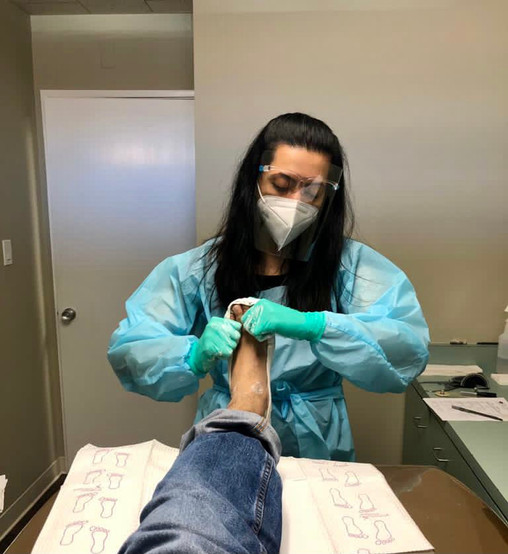Foot Inserts
- Kalgi Parmar
- Feb 14, 2022
- 5 min read
Many times as I learn about patients' chief complaints (the primary reason that brings one to see a doctor, a foot doctor in my case) and as I perform a physical exam, I find that the symptoms the patients are experiencing are in fact intertwined with a deeper root problem which has not been addressed. This is often the reason why patients may feel their notorious pains and aches to frequently visit them despite treatment.
For instance, you may experience severe heel pain one morning. You try resting, icing, changing your shoe gear, and anti inflammatory medication which helps relieve the pain. So you carry on about you day(s) forgetting the heel pain. A few weeks later, the same sharp pain revisits. Another bout of home regimen is performed until the pain comes back again. After a few repetitive cycles of self care is when patients generally seek further medical care. During the initial visit, history of the illness is obtained, physical exam is performed, x-rays are obtained before diagnosis and treatments are outlined. In the case of a bad heel pain, it may be that there is a flat foot condition which is otherwise asymptomatic and therefore not addressed medically, but is the culprit causing recurring plantar fasciitis.
In these instances, addressing the root cause helps to directly and/or indirectly address the symptomatic conditions that patients come in with. One of the most effective conservative (without surgery) ways of addressing underlying and chronic lower extremity conditions is through foot inserts.
What are Foot Inserts?

Foot Inserts or orthotics are inserts that fit inside of your shoes to provide cushion, comfort, pain relief, correction and/or accommodation to prevent further deterioration of a condition.
Think of the lower extremities as cascades. All the joints of the lower extremities rest on the ones below; i.e. the lower back rests on the hips, hips on the knees, knees on the ankles, and the ankles on the 33 joints of the feet! Therefore, naturally if any of these joints in the sequence are injured or out of alignment, they will eventually disturb others surrounding them. Orthotics, more specifically functional orthotics, work by realigning the lower extremity joints into their neutral position and therefore correct how we stand, walk, and function. This in turn can help address many chronic conditions and pains.
Before I recommend orthotics to my patients, I obtain a thorough history, perform a physical exam, including a comprehensive biomechanical evaluation of their lower extremities, and review imaging to understand what type of orthotic corrections will best address their lower extremity problems.
Common conditions that respond to Orthotics
While I genuinely believe that just about everyone can benefit from some type of an orthotic device in their shoes, there are certain conditions that respond particularly well to orthotic treatment such as ones listed below:
Flat foot
High arch
Plantar fasciitis
Bunion & Hammer toes
Degenerative arthritis
Tendinitis and ligament strains
Bony prominences
Charcot arhtopathy
Diabetic peripheral neuropathy
Corns and calluses
These are only some of the many conditions in which orthotics are used as an effective treatment method. Keep in mind that while orthotics are a great treatment options for many conditions, they are a conservative treatment method and therefore, may not reverse or completely resolve chronic conditions. They are an adjunct to other treatments and can certainly aid in keeping chronic conditions at bay until further interventions maybe required.
Types of Foot Inserts
There are many different types of orthotics and they all serve different purposes. An orthotic that is better for one person may not always be the same type of orthotic that may benefit another person.
Functional/Corrective Inserts

Functional inserts are custom foot orthoses (CFOs) that are custom molded to your feet. They function by correcting or realigning our stance and gait cycle to a neutral position. Because they alter how we stand and walk, there is a break in period associated with CFOs to allow the muscles and joints of the lower extremities to adapt to a new and a balanced way of walking. CFOs are generated by obtaining impressions of the feet through casting, molding, or digitally after which a unique orthotic prescription is created for each foot that is not merely a mirror image of the other. A wide variety of materials can be used to make specifications to custom orthotics that address various pathologies and can fit into a variety of shoe gear.
Accommodative Inserts

As the name suggests, accommodative inserts exist to accommodate to various deformities. Accommodative orthotics work great to provide comfort and protection of at risk areas of the foot/ankle and advanced deformities that may not be appropriate for surgical correction. Patients who may not tolerate the correction of a functional orthotic may be best served with custom or medical grade accommodative orthotics. They are typically made out of layers of foam and plastazote materials which provide comfort and protection. Diabetic inserts are an example of accommodative orthotics.
Medical Grade Inserts

Medical grade orthotics are prefabricated inserts that can be found at health care facilities or doctor's offices. While they are not custom molded to one's feet, they are generally optimum medical grade inserts that serve to provide arch support and comfort to most foot types. They have some features of a custom orthotic which make them a great starting point for someone who is new to foot inserts.
Over the Counter Inserts
These come in a variety of shapes, brands, and prices. Some provide with better support and durability than others. In my practice, I find that patients have generally tried some type of commercially available orthotics with varying degrees of success prior to coming in for an evaluation. My general recommendation is to discuss orthotics with your podiatrist prior to making a purchase to ensure that you are using a device that will best provide you with the support your feet require.
One important consideration with orthotic use is that orthotics (of any type) are only as good as the shoes they are placed in. So it's important to pair your foot inserts with a supportive pair of shoes that aren't worn out. And similar to breaking into a new pair of shoes, it is also important to break into your orthotics gradually so that the muscles and joints of the lower extremity can adapt to a corrected way of standing and walking. Once your orthotics feel comfortable with day-to-day use, you can start using them during all of your athletic activities.
We spend just about the half of our day on our feet while working, standing, walking, working out, and much more. So treating them to a good pair of shoes and inserts will ensure that our feet allow us to remain active, healthy and pain free for years to come! Talk to your podiatrist to see if you could benefit from adding orthotics to your shoes.











Dr.Kalgi, Very nice information and guidance for foot care, thanks